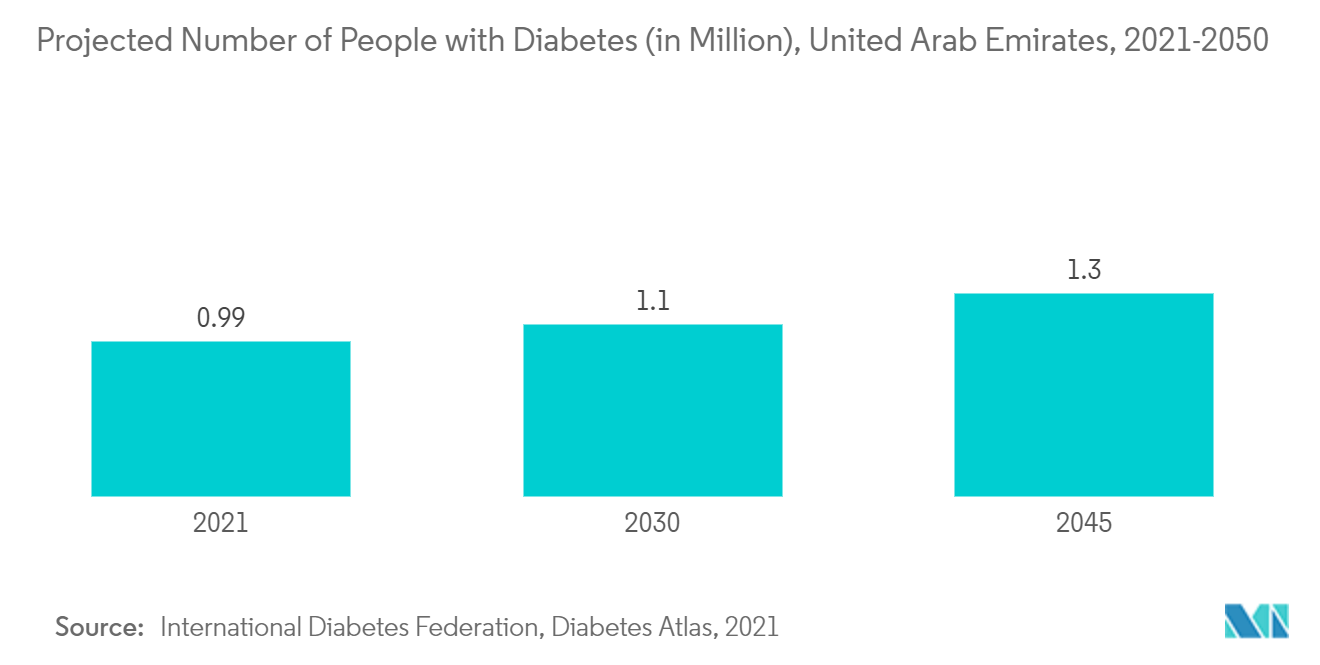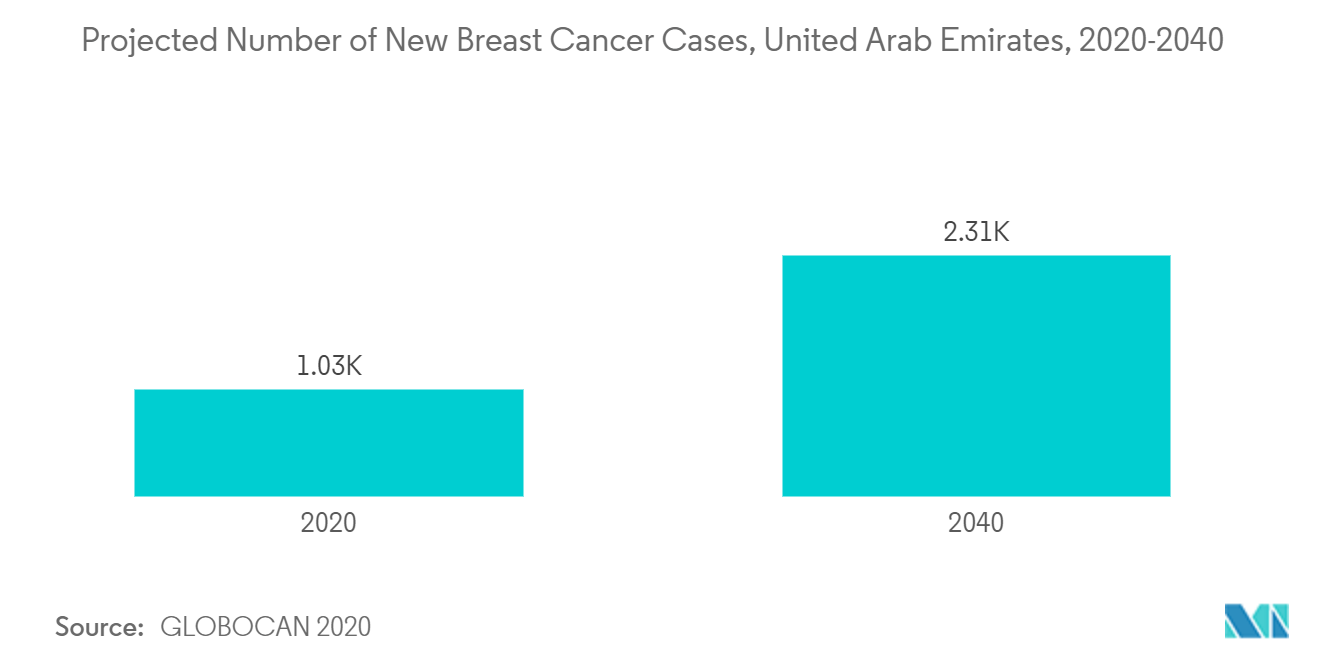Market Trends of United Arab Emirates General Surgical Devices Industry
This section covers the major market trends shaping the UAE General Surgical Devices Market according to our research experts:
Cardiology Segment is Anticipated to Witness Growth Over the Forecast Period
The cardiology segment is expected to witness significant growth in the general surgical devices market in the United Arab Emirates over the forecast period owing to factors such as the rising prevalence of cardiovascular diseases such as stroke, hypertension, and heart attack and their associated risk factors.
In addition, the presence of well-established healthcare infrastructure in the country also increases the demand for advanced surgical devices, thereby propelling segment growth. For instance, as per the data published by the ITA in July 2022, the United Arab Emirates is one of the most economically developed and diversified markets with a strong healthcare infrastructure. In addition, as per the same source, the government approved a federal budget of USD 15.8 billion (AED 58.931 billion) for public spending, of which 8.4% is dedicated to healthcare.
Cardiovascular disease (CVD) is the major cause of mortality in the country. For instance, as per an article published in the American Journal of Preventive Cardiology in December 2021, it has been observed that the United Arab Emirates has the second-highest cardiovascular mortality rate after Saudi Arabia and is higher than the average for Gulf Cooperation Council (GCC) nations. This is anticipated to increase the demand for cardiovascular surgeries, thereby boosting the growth of cardiology devices over the forecast period.
Additionally, according to the 2022 statistics published by the IDF, about 0.99 million people were living with diabetes in 2021 in the United Arab Emirates, and this number is projected to double by 2050. Thus, the expected increase in the diabetic population in the country may lead to a rise in cardiovascular complications, which is anticipated to boost the demand for surgeries, hence propelling the market's growth.
Similarly, as per a meta-analysis study published in December 2021, it has been observed that the combined prevalence of hypertension ranges between 20 and 35% in the country. In addition, as per the same source, the prevalence of hypertension was higher in Dubai than in the Abu Dhabi region. Thus, the elevated blood pressure in the population causes the left ventricle to thicken, which increases the risk of heart attack and cardiac failure. This is expected to augment segment growth over the forecast period.
Furthermore, the rising company activities and increasing focus on the adoption of various business strategies such as collaboration, partnerships, and others to develop advanced handheld devices for managing cardiovascular conditions This is also expected to drive segment growth over the forecast period. For instance, in March 2022, BioIntellisense, Inc. entered into a strategic collaboration with Mubadala Health to develop remote care technologies to drive clinical workflow efficiencies, unlock data-driven clinical insights, and deliver a personalized care experience. This collaboration with Mubadala Health offers a tremendous opportunity to apply the BioSticker and BioButton wearable medical devices in a variety of healthcare settings, simplify early detection, and provide care teams with individualized clinical intelligence that enables proactive, well-informed interventions.
So, the studied segment is likely to grow over the next few years due to the factors mentioned above, such as the growing number of cardiovascular diseases and the factors that go with them, as well as the growth of company activities.

Laparoscopic Devices Segment is Expected to Have the Significant Market Share Over the Forecast Period
The laparoscopic devices segment is expected to witness healthy growth in the general surgical device market over the forecast period owing to factors such as the rising prevalence of chronic diseases, increasing technological advancements, and rising demand for minimally invasive surgical procedures.
The rising burden of cancer, liver diseases, obesity, and others is the key factor driving the need for surgeries, hence propelling the demand for laparoscopic devices. For instance, according to the GLOBOCAN report, the estimated number of new breast cancer cases in the United Arab Emirates (UAE) is projected to reach 2,306 by 2040. As per the same source, about 2,306 new breast cancer cases are expected to be diagnosed in the United Arab Emirates by 2040.
Additionally, according to an article published in July 2021, about 372,000 people are projected to develop non-alcoholic fatty liver disease (NAFLD) in the United Arab Emirates by 2030. In addition, as per the same source, the prevalence of NAFLD was expected to rise by 87% by 2030 in the UAE. Thus, the expected increase in the population suffering from NAFLD is expected to increase the demand for laparoscopic surgeries, which in turn is anticipated to propel the demand for laparoscopic devices and laparoscopes, hence boosting segment growth.
The growing demand for minimally invasive surgeries (MIS) also increased market growth, as they cause less post-operative pain and patients receive smaller dosages of painkillers. As only minimal cuts or stitches are involved, the hospital stay is relatively shorter, and patients need not visit the hospital frequently. Also, the advantages of MIS over traditional open surgeries include producing a better and magnified image of the organs or body parts being operated on and higher precision due to video-assisted equipment.
Furthermore, the rising technological advancements and emerging trends of robotic surgery by surgeons during complex surgeries are expected to increase the market's growth over the forecast period. For instance, in October 2022, Sheikh Shakhbout Medical City (SSMC) performed its first robot-assisted gynecological surgery to treat abdominal pain in a patient due to a large pelvic mass on the left ovary. Also, in June 2022, Muna Kishwai performed robotic surgery to perform total and supra-cervical hysterectomies, cure uterine prolapse, and remove fibroids at a government-run hospital in the UAE.
Therefore, owing to factors such as the rising burden of chronic diseases, the increasing advantages of minimally invasive surgeries, and the increasing adoption of robotic and computerized surgeries in the country, the studied segment is expected to grow over the forecast period.


